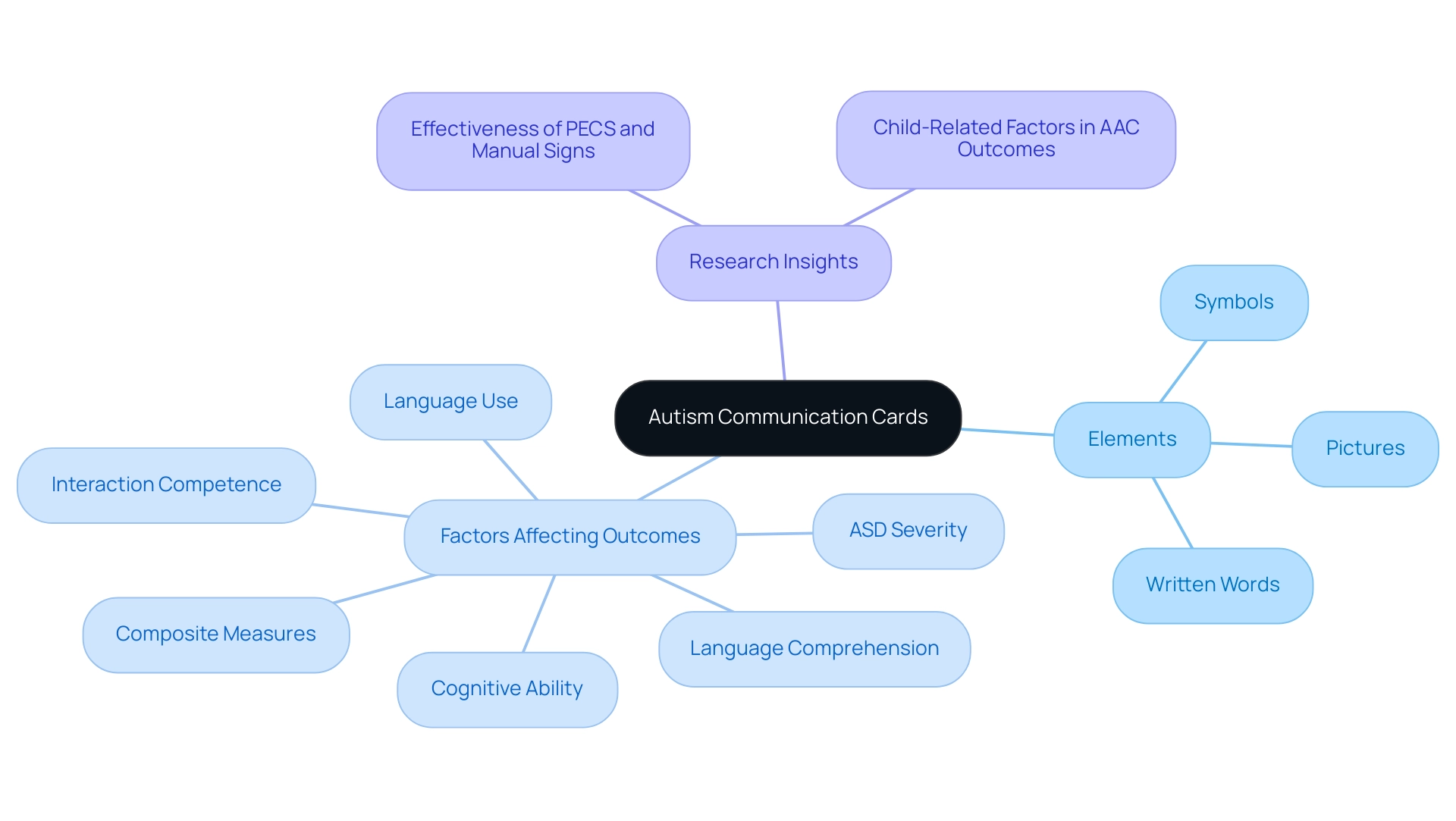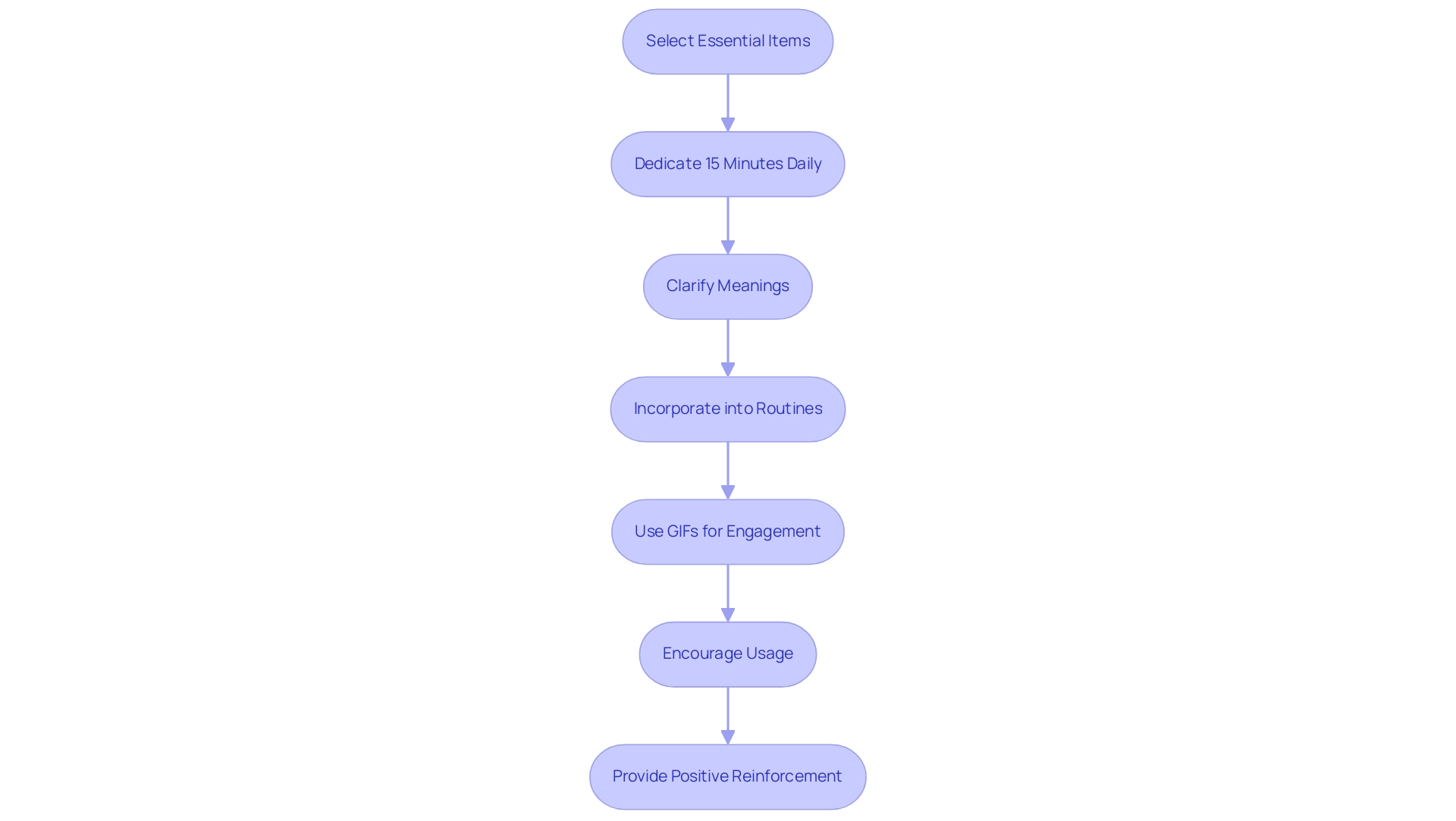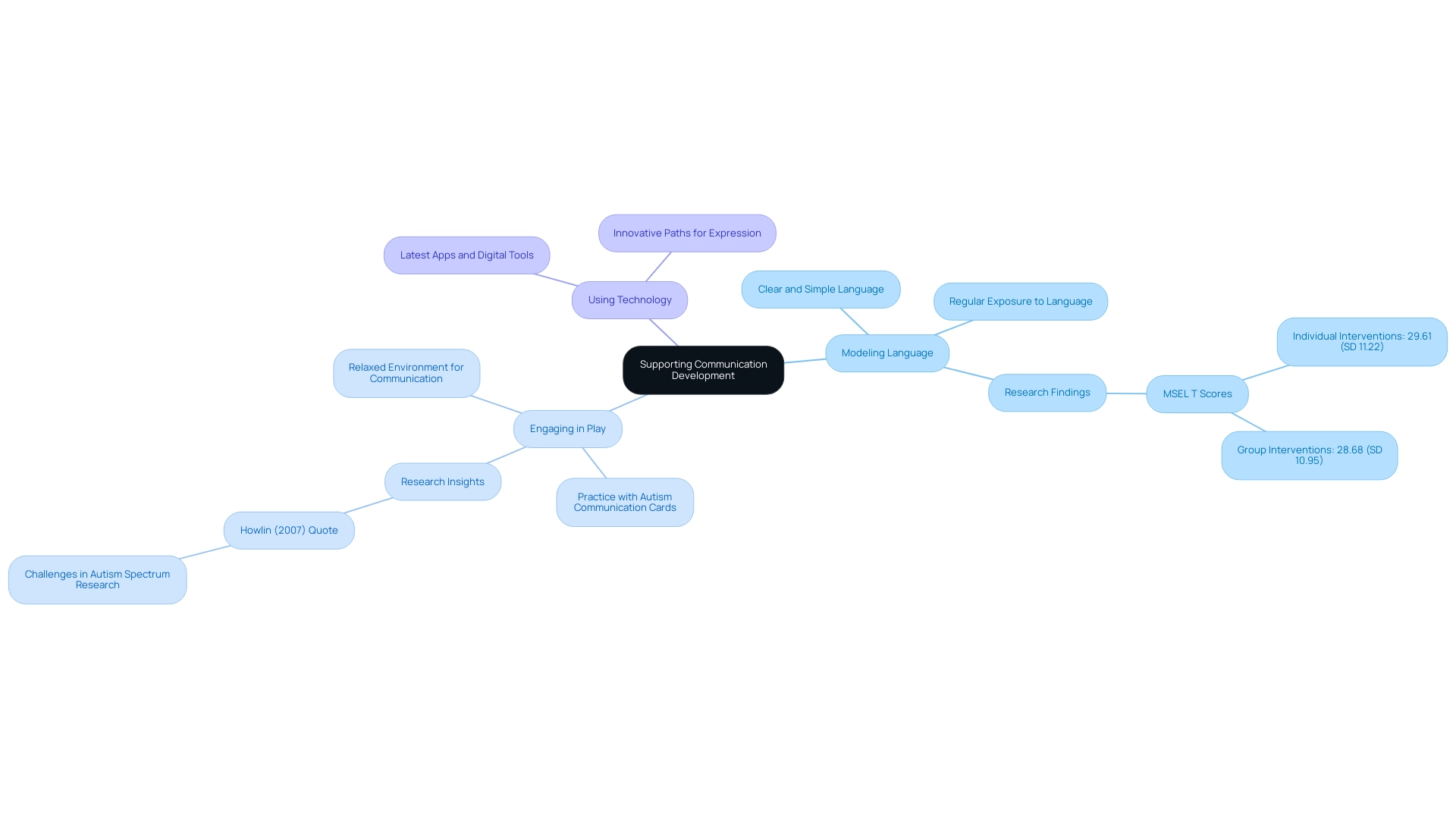Introduction
In a world where effective communication is vital for connection and understanding, autism communication cards emerge as transformative tools, empowering children to express their thoughts and emotions. These visual aids, ranging from picture cards to word combinations, cater to the unique communication needs of children with autism, enhancing their ability to navigate social interactions with confidence. As research underscores their effectiveness, parents and advocates are presented with a powerful resource that not only fosters independence but also reduces anxiety and enriches social experiences.
This article delves into the multifaceted benefits of communication cards, offering practical guidance on their introduction and use, while exploring various types tailored to individual needs. By embracing these tools, a supportive and inclusive environment can be cultivated, paving the way for meaningful connections and improved quality of life for children with autism.
Understanding Autism Communication Cards
Autism communication cards act as strong aids that enable individuals with autism to articulate their needs, thoughts, and emotions effectively. These items can showcase a variety of elements, including pictures, symbols, or written words, each representing different concepts or actions. By utilizing these aids, young individuals can navigate their interaction challenges more successfully, significantly reducing frustration and fostering a deeper understanding in their exchanges.
The organized format of autism communication cards not only enhances expression but also makes conversations more accessible and meaningful for children. Recent research, including findings published in the American Journal of Speech-Language Pathology, emphasizes the effectiveness of these tools in supporting language development. Specifically, studies indicate that factors such as:
- cognitive ability
- ASD severity
- language comprehension
- language use
- interaction competence
- composite measures
significantly affect outcomes in ASD.
By customizing these notes to personal traits—like those highlighted in the systematic review titled 'Factors Related to Youth in AAC Outcomes'—parents and supporters can develop a personalized strategy that enhances interaction results for their offspring. As M.C.R. stated, 'All authors have read and agreed to the published version of the manuscript,' reinforcing the collaborative effort behind this research.
Ultimately, the use of autism communication cards not only enhances the young person's capacity to engage with others but also fosters a more inclusive and supportive atmosphere.

How to Introduce and Use Communication Cards Effectively
To effectively introduce autism communication cards, begin by selecting a few essential items that capture common needs or emotions, such as 'hungry,' 'happy,' or 'help.' Start small by dedicating just 15 minutes a day to this activity, gradually increasing the time as your young one becomes more comfortable. Present these items to your offspring, clarifying their meanings in simple terms.
Incorporate these items into daily routines by demonstrating their application in context. For example, if your child shows hunger, hold up the 'hungry' symbol while saying the word aloud. This helps establish a clear link between the item and the concept.
You can also boost engagement by including GIFs associated with the items, making interaction more enjoyable and engaging. Encourage your child to utilize the autism communication cards by prompting them during interactions, and remember to celebrate their attempts to communicate—whether it’s making a sound, making eye contact, or touching the cards. As Rachel Madel wisely notes,
Communication attempts can be as simple as making a sound, making eye contact, or touching anywhere on the board.
Positive reinforcement for their efforts will build their confidence and foster a supportive environment for their development. Additionally, grasping the wider support systems accessible, like those emphasized in the case study on ASD assistance in New Mexico, can offer important context for the use of messaging tools within comprehensive support services.

Exploring Different Types of Autism Communication Cards
Among the diverse array of autism expression tools, several types stand out for their unique advantages and uses:
- Picture Tools: Utilizing vivid images to represent objects, actions, or emotions, these tools are particularly effective for non-verbal youngsters. Autism communication cards enable prompt comprehension and expression, allowing youngsters to convey their needs and emotions more effortlessly.
- Word Flashcards: Featuring written vocabulary, these tools assist young learners in acquiring reading skills and recognizing essential terms. This method not only assists interaction but also promotes literacy abilities that are essential for academic achievement.
- Combination Tokens: Combining both images and words, these tokens accommodate different learning preferences. They not only improve verbal interaction but also encourage literacy, making them a versatile option for many youngsters.
The selection of autism communication cards should be guided by each individual's unique needs and preferences. Recent innovations in autism communication cards reflect a growing understanding of how tailored resources can significantly enhance social interaction skills. As highlighted in the Panerai et al. (1997) study, where a year-long intervention using structured educational approaches benefited children with ASD, selecting the right interaction tools can profoundly influence a young person's ability to connect with others. This study, along with findings from the literature with a PMID of 30517284, highlights the effectiveness of assistance tools in supporting youngsters with autism.
Speech therapists have recognized the significance of these tools, stating that 'the efficacy of these aids lies in their ability to engage youngsters where they are.' Furthermore, as Antão JY emphasized, researchers must be responsible for all aspects of their work to ensure that inquiries related to the accuracy or integrity of any part of the work are appropriately investigated and resolved. By exploring these options, parents and educators can empower their young ones to navigate their world more confidently and effectively.
Benefits of Using Autism Communication Cards
Utilizing autism interaction cards offers a multitude of benefits that significantly enhance a young person's development and quality of life:
-
Promoting Independence: Interaction cards empower individuals to articulate their needs and desires, fostering a sense of self-advocacy and independence. This independence is essential for fostering confidence in their skills.
-
Reducing Anxiety: Clear channels of interaction lessen frustration for young people, contributing to lower anxiety levels in social situations. P. Howlin (2014) endorses this idea, stating,
Overall, PECS seemed to improve young individuals' spontaneous expression for instrumental requesting using images, speech, or a blend of both.
This emphasizes how efficient interaction tools can reduce the anxiety frequently linked to social engagements. -
Improving Social Engagements: By promoting significant exchanges, interaction aids allow children to connect more effectively with peers and adults. This enhanced interaction not only enriches their social experiences but also supports their overall emotional well-being.
The positive outcomes associated with autism communication cards extend beyond immediate engagement improvements. Secondary outcomes, including enhanced social interaction skills, improved quality of life, and increased parent satisfaction, further illustrate their value. Case studies, including the 2006 randomized trial by Yoder, show that the use of autism communication cards, such as PECS, surpassed other techniques in enhancing non-imitative spoken interactions and vocabulary among individuals with autism.
These findings highlight the essential function that support tools serve in cultivating important life skills, rendering them an invaluable asset for promoting autonomy and improving the overall welfare of youth.
Supporting Communication Development Beyond Cards
To effectively support interaction development beyond the use of traditional cards, it is essential to incorporate a variety of strategies that engage young learners holistically. These include:
- Modeling Language: Use clear and simple language during interactions to encourage children to mimic and learn. This regular exposure to language helps to strengthen skills in everyday situations. Research indicates that the MSEL T scores are 29.61 (SD 11.22) for individual interventions and 28.68 (SD 10.95) for group interventions, suggesting that structured approaches can significantly improve interaction outcomes.
- Engaging in Play: Leverage play-based activities, which create a relaxed environment for communication. Through play, children can practice using their autism communication cards while verbalizing their thoughts, which enhances their ability to express themselves naturally. As noted by Howlin (2007), "It is difficult in autism spectrum research to control for interventions being obtained in the local community," highlighting the necessity of comprehensive strategies that include play. Research indicates that play is a pivotal element in fostering interaction skills, as it allows for exploration and experimentation in a stress-free context.
- Using Technology: Embrace the latest apps and digital tools designed to enhance interpersonal skills. These technologies provide innovative paths for expression, facilitating interaction in ways that resonate with young people in today’s digital age.
By integrating these diverse strategies, parents and educators can cultivate a rich communication environment that utilizes autism communication cards to nurture the growth and development of children with developmental differences. This multifaceted approach aligns with findings from the World Health Organization's ICD-10 guidelines, which provide clinical descriptions and diagnostic guidelines for mental and behavioral disorders, including autism. As noted in the literature, it is crucial to remain aware of the various interventions available, as contextual factors can significantly influence the effectiveness of these approaches.

Conclusion
Autism communication cards serve as invaluable tools that not only enhance communication skills but also foster independence and reduce anxiety for children on the spectrum. By utilizing various types of cards, including picture, word, and combination cards, parents and advocates can tailor their approach to meet individual needs, thereby creating a supportive environment that encourages meaningful interactions. The evidence supporting the effectiveness of these tools is compelling, as research highlights their role in promoting social communication and enriching the overall quality of life for children with autism.
Introducing and effectively using communication cards involves starting with essential concepts and gradually integrating them into daily routines. This process not only builds confidence in children but also reinforces their ability to express their thoughts and feelings. The positive outcomes extend beyond immediate communication improvements, fostering a sense of self-advocacy and enhancing social engagement.
Ultimately, the journey towards improved communication for children with autism is multifaceted. By embracing a variety of strategies, including modeling language, engaging in play, and leveraging technology, parents and educators can create an enriching environment that nurtures communication development. The collective efforts to utilize communication cards and holistic strategies pave the way for meaningful connections, empowering children to navigate their world with confidence and joy.
Frequently Asked Questions
What are autism communication cards?
Autism communication cards are tools that help individuals with autism express their needs, thoughts, and emotions. They can include pictures, symbols, or written words that represent different concepts or actions.
How do autism communication cards benefit individuals with autism?
These cards help young individuals navigate interaction challenges, reducing frustration and promoting a better understanding in their conversations. They enhance expression and make communication more accessible and meaningful.
What research supports the effectiveness of autism communication cards?
Recent research, including findings from the American Journal of Speech-Language Pathology, highlights their role in supporting language development. Factors such as cognitive ability, ASD severity, language comprehension, and interaction competence significantly affect outcomes in ASD.
How can parents customize autism communication cards for their child?
Parents can develop a personalized strategy by tailoring the cards to their child's specific traits and needs, as indicated in the systematic review titled 'Factors Related to Youth in AAC Outcomes.'
What is the recommended approach to introduce autism communication cards to a child?
Begin by selecting a few essential items that represent common needs or emotions, dedicating 15 minutes a day to this activity. Gradually increase the time as the child becomes more comfortable, and incorporate the cards into daily routines by demonstrating their use in context.
How can engagement with autism communication cards be enhanced?
Engagement can be boosted by including GIFs associated with the items and encouraging the child to use the cards during interactions. Positive reinforcement for their communication attempts, such as making sounds or eye contact, helps build confidence.
What additional support systems are beneficial for using autism communication cards?
Understanding the broader support systems available, such as those highlighted in case studies on ASD assistance, can provide important context for utilizing communication tools effectively within comprehensive support services.




